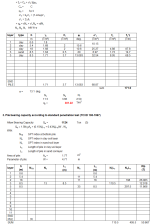bore pile design bs 8004

Description
Spreadsheet to calculate pile bearing capacity of drilled shaft foundation - bore pile according to BS 8004. For preliminary design purposes, BS 8004 gives presumed bearing values
which are the pressures which would normally result in an adequate factor
of safety against shear failure for particular soil types, but without
consideration of settlement.
| Category | Types of rocks and soils | Presumed bearing value |
| Non-cohesive soils | Dense gravel or dense sand and gravel | >600 kN/m² |
| Medium dense gravel,
or medium dense sand and gravel |
200 to 600 kN/m² | |
| Loose gravel, or loose sand and gravel | 200 kN/m² | |
| Compact sand | >300 kN/m² | |
| Medium dense sand | 100 to 300 kN/m² | |
| Loose sand | 100 kN/m² depends on
degree of looseness |
|
| Cohesive soils | Very stiff bolder clays & hard clays | 300 to 600 kN/m² |
| Stiff clays | 150 to 300 kN/m² | |
| Firm clay | 75 to 150 kN/m² | |
| Soft clays and silts | 75 kN/m² | |
| Very soft clay | Not applicable | |
| Peat | Not applicable | |
| Made ground | Not applicable |
Calculation Reference
Reinforced Concrete Design
Design of Footings
ACI 318-08
The calculation of pile bearing capacity for drilled shaft foundation or bore pile, following BS 8004, involves the following steps:
- Determine the soil properties, such as the soil type, unit weight, angle of internal friction, and cohesion.
- Determine the diameter and length of the pile.
- Determine the ultimate bearing capacity of the pile using one of the following methods: a. The static load test, which involves applying a static load to the pile and measuring the deflection and load. b. The dynamic load test, which involves measuring the acceleration of the pile and calculating the ultimate capacity using an empirical formula. c. Analytical methods based on the soil properties and the pile geometry, such as the Schmertmann method or the Broms method.
- Calculate the allowable bearing capacity of the pile by applying a factor of safety to the ultimate bearing capacity, typically ranging from 2.0 to 3.0.
- Determine the required size and length of the pile based on the allowable bearing capacity and the design loads.
The analysis of pile bearing capacity can be further refined by considering other factors, such as the presence of groundwater, the effect of soil stratification, and the effect of soil consolidation. The analysis can also be performed using computer software or spreadsheet programs, which can provide more accurate and efficient results.
Overall, the calculation of pile bearing capacity for drilled shaft foundation or bore pile, following BS 8004, provides a systematic and reliable approach to design and construct foundations that can support the required loads and ensure the stability and safety of the structures.
Calculation Preview
Full download access to any calculation is available to users with a paid or awarded subscription (XLC Pro).
Subscriptions are free to contributors to the site, alternatively they can be purchased.
Click here for information on subscriptions.



